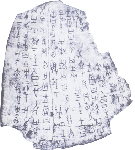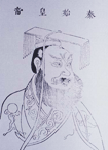Historical milestones China


The emperor Qin Shi Huang Di 奏始皇帝 burned to ashes the classical books and asked his Prime Minister Li Si 李斯 to create a one and only official list of characters. Limited to 3,300 characters, this list 三倉 is elaborated with the former existing characters, generalizing the principle of :
"basic phonetic primitive + key"
According to this principle, knowing a list of 56 keys and 57 phonetic primitives would have been sufficient to generate the list (56+57+56x57=3,305). Graphically, the characters, drawn with a brush, had to be written in a standard sized square. This style defines the so-called "small seal" 小篆 style.

7th edition of the list. The number increases to reach 7,800 characters. The central power weakening, pronunciations start to vary according to provinces and careless copies 奇字 ensue ; this entails now interpretation difficulties, although the original was straight forward. 96 A.D. Editing of the posthumous work of Xu Zhen 許愼 : the 説文解字 (ShuShuō wén jiĕzì or せつぶんかいじ) in Japanese) which classified 9,353 characters derived from the Li Si list.




